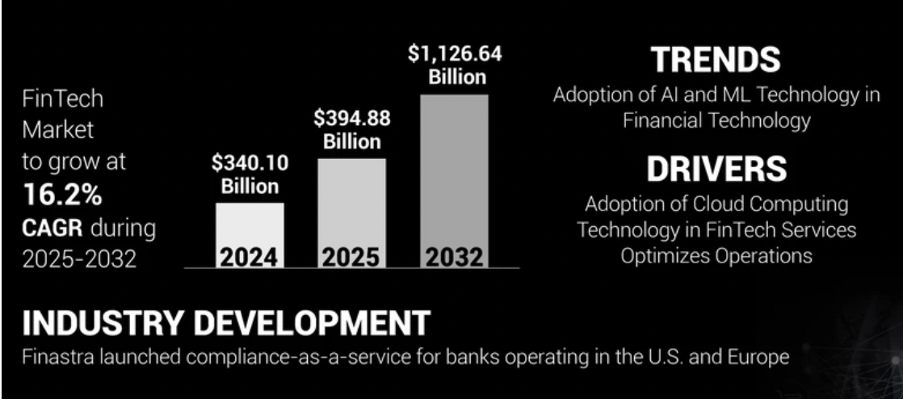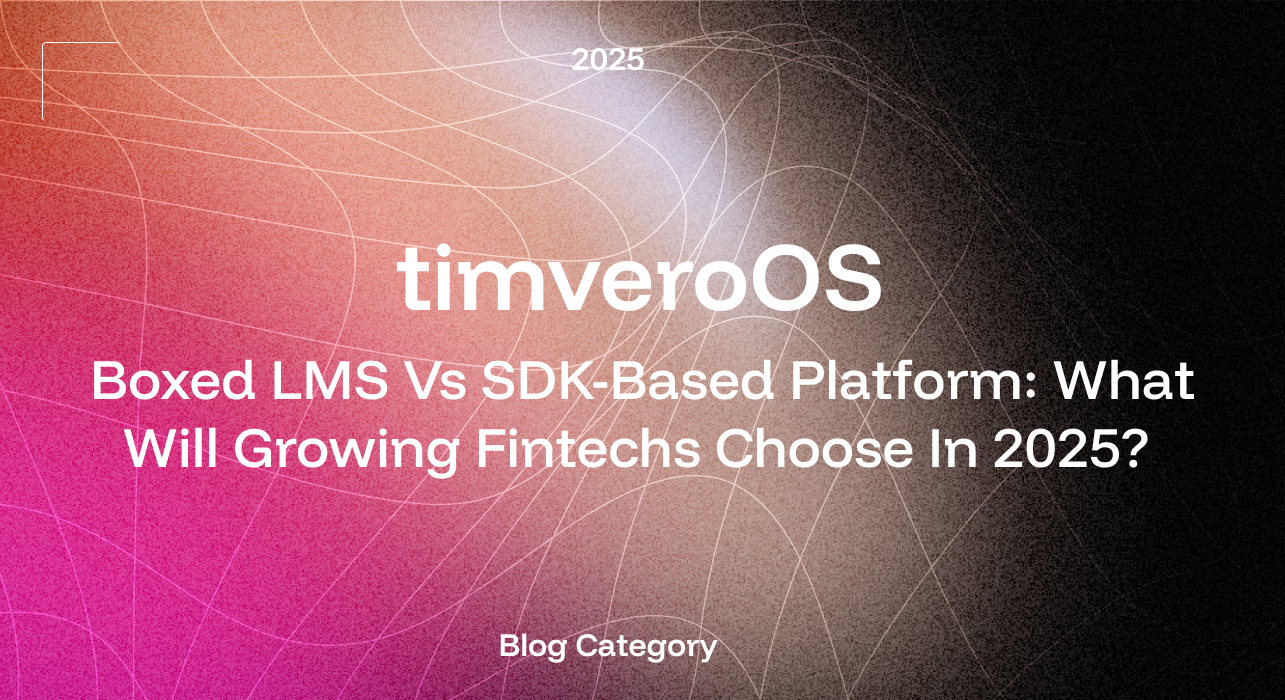Boxed LMS vs SDK-Based Platform: What Will Growing Fintechs Choose in 2025?
On one side are boxed loan management systems (LMS), which are out-of-the-box, feature-complete platforms that promise speed and reliability.
On the other hand, SDK-based, composable architectures offer modular control and deep customisation.
Valued at roughly USD 340 billion in 2024, the fintech market is projected to experience a more than threefold increase in less than a decade (Fortune Business Insights, 2025). As the industry barrels toward $1.1 trillion by 2032, the infrastructure decisions fintechs make today will define how far (and how fast) they can go.

Growth in this sector demands more than just speed to market. It requires flexibility, precision, and the ability to evolve lending products in real time. What starts as a race to launch quickly becomes a test of how well your infrastructure can handle complexity, growth, and change simultaneously.
Nowhere is that tension more visible than in the choice between boxed loan management systems and SDK-based platforms. Boxed LMSs offer speed, with prebuilt modules, standardised workflows, and rapid compliance out of the gate. But they come with hard limits, especially for fintechs looking to expand into new markets, design custom credit products, or respond to real-time user behaviour.
SDK-based platforms offer a different path. Built for adaptability, they let fintechs shape every layer of the lending stack, from risk engines and repayment logic to compliance workflows and collections strategies.
Brief overview of Boxed LMS vs SDK-Based Platforms
Boxed LMS platforms have dominated the lending tech stack for good reason. Providers like TurnKey Lender, LoanPro, and Mambu offer end-to-end functionality out of the gate: borrower onboarding, credit scoring, origination, servicing, collections, and reporting. Their value prop is simple: get up and running quickly, with workflows that comply with regulatory standards across multiple jurisdictions. For early-stage fintechs, the model is compelling. Product teams avoid years of backend buildout, engineering cost is deferred, and lenders can launch new credit products in weeks. But this appealing speed hides inflexibility.
As a fintech grows, boxed systems tend to become bottlenecks. Custom product design pushes these platforms beyond their current capabilities. Some examples are dynamic credit lines, multi-party lending, embedded B2B financing, or decentralised collateral models. The architecture behind boxed LMSs is often monolithic, with limited ability to tweak logic without vendor involvement. And that’s before you consider integrations. Want to connect your proprietary underwriting engine or layer in external behavioural data sources? Prepare for delays and vendor-side friction. So, in a market that actually rewards iteration, boxed LMSs impose a ceiling on differentiation.
SDK-based LMS frameworks take a radically different approach. Rather than offering a fixed experience, they provide the infrastructure of APIs, microservices, and developer kits that fintechs need to construct their own loan management logic, tailored to their specific ecosystem.
Do you need to embed lending directly into your main app's UI? SDKs allow that. Want flexible repayment scheduling triggered by borrower cash flow data? Build it. Need to support multiple lending jurisdictions with distinct compliance logic? Spin up parallel rule engines under the same infrastructure. But SDK-based platforms don’t offer speed-to-market in the same way boxed LMSs do. They require upfront engineering investment. But they offer something far more valuable in the long run: strategic optionality.
Loan Product Complexity: The Limit of Presets
Boxed LMS platforms come with predefined product types (e.g. term loans, revolving credit, buy-now-pay-later (BNPL), and payday loans_ with set configurations for interest calculation, repayment cadence, grace periods, delinquency triggers, and write-off rules. For simple consumer credit products, this works. However, for anything more bespoke (e.g. deferred repayments for gig workers, income-linked repayments, or carbon credits as collateral), boxed systems struggle.
SDK-based platforms enable fintech teams to build lending products that accurately reflect how credit should function in the real world. Instead of clicking through preset menus, developers define logic in code, giving them complete control over the structure, behaviour, and edge cases of each product. That means you can implement amortisation schedules tailored to seasonal cash flows, adjust credit limits automatically based on spending or risk signals, or pause repayments when income data flags volatility. For crypto lending, it enables live on-chain collateral valuation and smart contract enforcement; all of these are functions that boxed systems simply weren’t built to handle.
If your product requires anything outside the standard fixed-rate, monthly repayment model, boxed systems become a liability. You’ll hit limitations quickly, and solving them typically means building middleware layers, negotiating with vendors, or working around rigid templates, which slows down iteration and adds complexity to the stack. SDKs remove that constraint. They let your team build the lending logic the business actually needs with no bottlenecks and no compromises.
Core Banking & Risk Integration
Boxed loan management systems offer a preassembled toolkit, comprising KYC, credit scoring, collections, and notifications, designed for rapid deployment and regulatory compliance. But beneath the surface, these integrations are often inflexible and opaque. You inherit someone else’s logic, and your ability to modify it is limited by rigid APIs, static data models, and minimal access to the signals that actually drive lending performance. Custom risk frameworks, nuanced underwriting, and behavioural credit models become difficult or impossible to implement without extensive vendor intervention or disruptive workarounds that erode system stability.
SDK-based platforms invert that model. They’re built for fintechs that treat credit as a core competency, not a packaged feature. You don’t inherit logic, you get to define it. Want to feed transaction-level data into a proprietary machine learning model trained on behavioural delinquencies? You can. Need to sync risk signals with a real-time data pipeline in Snowflake or BigQuery? Straightforward. You can calibrate repayment nudges based on user engagement patterns, trigger fraud checks off-device metadata, or build dynamic risk bands from payroll, location, or biometric inputs.
So, without any exaggeration, the control SDKs offer is vital if you’re running multi-variable scoring models or using alternative data (e.g., payroll, transaction histories, device telemetry) as part of real-time credit decisions.
Multi-Jurisdiction Compliance
Loan products are inherently local: what works in India (with RBI rules and Aadhaar verification) differs significantly from what works in Brazil, the UK, or Indonesia.
Boxed systems typically support a few key geographies with prebuilt regulatory logic. But that support doesn’t scale with your growth. Compliance updates are rolled out according to the vendor’s schedule, and customisation (e.g., adding region-specific disclosures or storage requirements) may be limited.
Yet, SDK platforms allow fintechs to:
- Create jurisdiction-specific compliance workflows
- Store and process data in-region (for GDPR, PDPA, LGPD compliance)
- Add localised underwriting and repayment behaviours
- Update logic instantly across regions from a central control panel
This is non-negotiable for fintechs pursuing cross-border expansion or embedded credit strategies.
Servicing, Collections & Lifecycle Control
For fintech lenders, borrower servicing has become a frontline function, as risk management and user experience preservation now occur in the same operational layer, and the tools to execute that precision matter. Lenders need infrastructure that supports live restructuring logic, behaviour-driven delinquency management, and communications that can shift tone, language, and channel based on user context. This includes automating payment plan adjustments, triggering interventions at precise delinquency thresholds, and managing collections with minimal friction.
Boxed loan management systems fall short here. Their templates rarely extend beyond static rules and fixed workflows. SDK-based platforms, by contrast, give lenders direct control over logic and timing, offering restructuring options at DPD30 if transaction data signals an income disruption, launching pre-collection WhatsApp prompts based on engagement history, applying conditional APR reductions for early payments, or halting auto-debits when real-time bank feeds indicate a low balance. These aren’t feature add-ons—they’re risk levers. In a market where delinquency margins are thin and borrower churn is expensive, only SDK infrastructure provides the granularity needed to manage both with precision.
The Verdict
Growth today doesn’t follow a straight line. Fintechs are launching multi-region operations, building for regulatory fragmentation, testing new risk models, and competing on repayment UX. None of that can be done efficiently on a boxed system with a rigid backend. Boxed loan management systems are designed for static use cases, including fixed loan types, basic repayment flows, and standard compliance modules. They’re fine for launching version one of a product. But growth introduces complexity across multiple jurisdictions, layered risk models, embedded finance partners, new user cohorts, and boxed systems don’t bend easily. Every change requires a workaround, a support ticket, or worse: a compromise.
SDK-based platforms are designed for this complexity. They provide fintechs with modular control over the entire lending stack, including origination, servicing, collections, and compliance, through APIs and logic layers that can be tailored to fit the product, not the other way around. Need to launch income-based repayments in one market and fixed-term loans in another? Run both from the same system. Want to A/B test restructuring logic or tailor collections based on real-time balance data? SDKs let you do it without vendor friction or rewrites.
Markets change. Risk appetites shift. Regulation evolves. Growth-stage fintechs that rely on boxed systems will be locked into rigid workflows precisely at the moment they need to move faster. SDKs provide the opposite: a foundation that scales with the company, not ahead of it or behind it, but in sync with it.
.avif)
